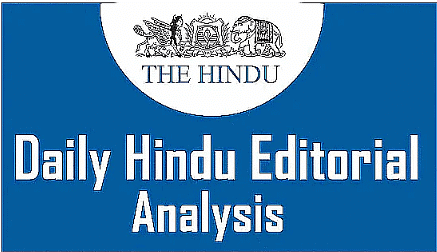The Hindu Editorial Analysis- 20th November 2023 | Current Affairs & Hindu Analysis: Daily, Weekly & Monthly - UPSC PDF Download

Steering road safety in India back onto the right lane
Steering road safety in India back onto the right lane
Why in News?
Each year, a staggering 3,00,000 people are estimated to be killed on the road in India, according to the United Nations World Health Organization (WHO). That is equivalent to more than 34 people every hour of every day. And that is a conservative estimate.
Introduction
The Annual Report on ‘Road Accidents in India-2022’ has been published by the Ministry of Road Transport and Highways. The report highlights that there are 53 road accidents and 19 deaths due to these road accidents per hour in India.
What are the key Highlights of Road Accidents in India report?
- Report Preparation Methodology- This report is based on the data/information received from police departments of States/UTs on calendar year basis in standardized formats as provided by the United Nations Economic and Social Commission for Asia and the Pacific (UNESCAP) under the Asia Pacific Road Accident Data (APRAD) base project.
Key Highlights-The key highlights of the report are summarised below-
| Increase in road accidents over the years | (1) There were a total 4,61,312 road accidents across the country in 2022, which claimed as many as 1,68,491 lives. (2) The number of road accidents in 2022 increased by 11.9% and deaths rose by 9.4% as compared to 2021. |
Increase in severity of accidents (Severity is the number of persons killed per 100 accidents) | (1)Severity of road crashes has increased over the past decade from 28.2 in 2012 to 36.5 in 2022. (2) There has been a consistent increase in the severity of cases every year even during the COVID times. |
Maximum deaths on the National Highways (NH) and State highways (SH) | (1) National and State highways, which account for only 4.9% of the total road network, witnessed 56.1% of all road crashes and almost 61% of all road crash fatalities in the country. |
States with Maximum deaths | Uttar Pradesh registered the highest share of deaths at 13.4%. This was followed by Tamil Nadu at 10.6% and Maharashtra at 9%. |
Demographic Distribution of deaths | (1) People in the 18-45 age bracket comprised 67% of the total fatalities in the road accidents. (2) Children death fatalities were around 9,528 in 2022. |
What are the reasons for the increase in Road accidents?
According to the report, the reasons for the increase in road accidents are mentioned below-
- Human errors and Traffic Rules Violations- Over speeding is the major cause and it accounts for 71.2 percent of the persons killed in 2022. Driving on the wrong side is the second reason accounting for 5.4 per cent deaths.
- Faulty Road Designs- Faulty road engineering leading to black spots, poor designing of junctions, inadequate signage, haphazard planning of state highways and city roads are also some major factors causing road accidents.
- Weak Vehicle Safety Standards in India- Crash tests carried out by the Global New Car Assessment Programme (NCAP) in 2014 revealed that some of India’s top-selling car models failed the UN (United Nations)’s frontal impact crash test.
- Lack of Golden Hour Treatment- Lack of rapid trauma care on highways leads to high fatalities.
- Low awareness- Indians have very low awareness regarding the importance of safety features like airbags, Anti lock Braking system, safety belt usage etc.
What are the impacts of road accidents in India?
- Economic Impact- As per the World Bank report, Indian economy looses 3 to 5 percent of its GDP each year due to road accidents.
- Social Impact- Vulnerable Road Users (VRUs) like the male urban poors, account for more than half of all road crash deaths and serious injuries in the country. These accidents further push them into extreme poverty as they are pushed out of employment.
- Gender-Specific Impact- According to World Bank’s report “Traffic Crash Injuries and Disabilities: The Burden on Indian Society 2021” , about 50% of Indian women were severely affected by the decline in their household income after a crash.
What measures have been taken in India to reduce road accidents?
Formulation of National Road Safety Policy (NRSP), 2010- The policy was formulated based on the recommendations of S Sundar Committee. Some of the important highlights are-
(a) Establishment of Road Safety Information Database.
(b) Periodical review of road design standards and Vehicle safety standards.
(c) Creation of National Road Safety Council to supervise matters related to road safety.
2. Establishment of District Road Safety Committees (DRSC)- Established under the Section 215 of the Motor Vehicle Act of 1988. These have been entrusted with creation of a district road safety plan and an emergency medical plan.
3. Passage of Motor Vehicles (Amendment) Act 2019- GOI has tried to enhance the road safety measures through this act.
(a) Creating a National Road Safety Board to advise the government on traffic management. (b) Higher fines for traffic rule violations.
(c) Recalling defective vehicles which are dangerous for the environment and people.
(d) Creation of a ‘Solatium Fund’ for victims of hit-and-run accidents.
(e) Punishment to the owner for violations committed by Juvenile.
(f) Automated testing for driver’s licence and fitness certificate (FC).
(g) Protection of Good Samaritans from civil and criminal liability.
4. Other technical initiatives- Further more, other technical initiatives have been taken which are mentioned below-
(a) Front and side crash tests for new car models.
(b) New cars are required to have airbags fitted as standard.
(c) Installation of Roadside Safety Crash barriers and speed warning boards.
(d) Rectification of identified Black spots.
|
38 videos|5293 docs|1118 tests
|





















